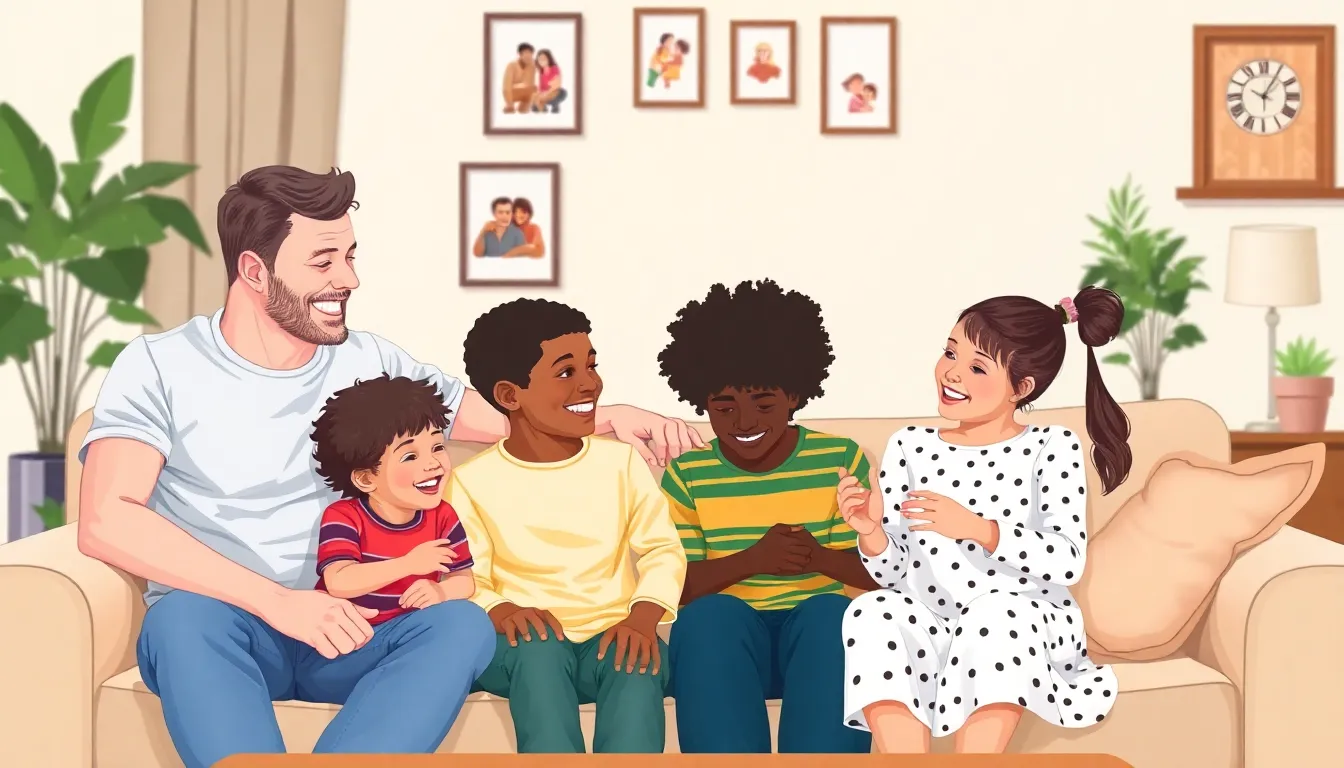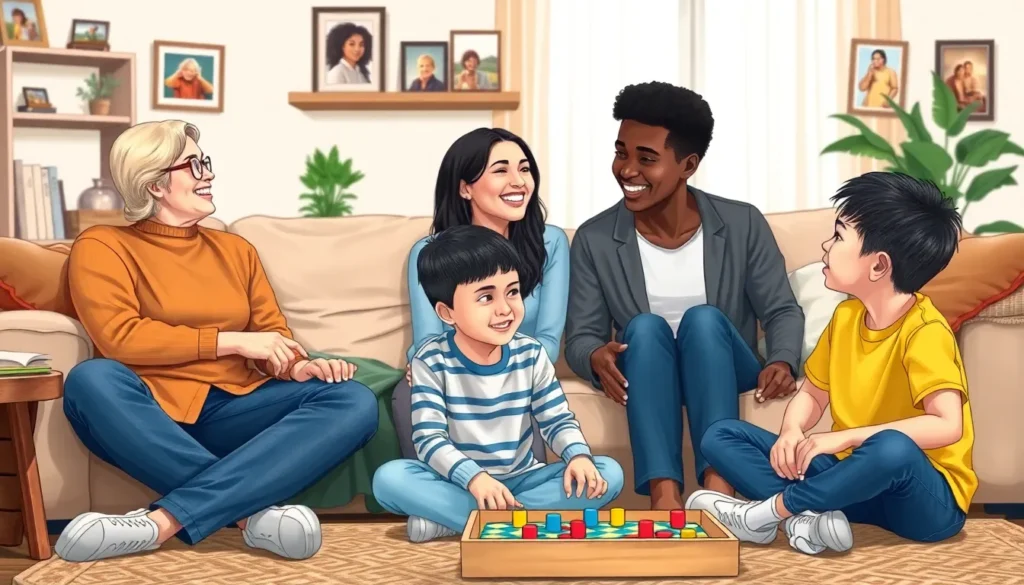Family dynamics psychology is like the ultimate reality show—full of drama, laughter, and the occasional plot twist. It dives deep into the intricate relationships that shape our lives, revealing how everything from sibling rivalries to parental expectations can influence our behavior and well-being. Understanding these dynamics isn’t just for therapists; it’s essential for anyone who’s ever had a family dinner that turned into a debate about who really ate the last slice of pizza.
In a world where family interactions can feel like a game of emotional chess, grasping the psychology behind these connections can be a game-changer. It helps people navigate their relationships with insight and humor. So, whether you’re trying to decode your teenager’s eye rolls or figure out why Aunt Sally insists on bringing that jello salad to every gathering, this exploration of family dynamics psychology is here to shed light on the quirks that make each family unique.
family dynamics psychology
Family dynamics psychology examines the complex relationships within families and their effects on individual behavior. This field of study reveals how family roles, communication styles, and interactions shape emotional well-being.
Definition and Scope
Family dynamics refers to the patterns of interaction and relationships within a family unit. This area of psychology addresses how these dynamics influence individuals’ thoughts, feelings, and actions. The scope encompasses various components, including roles, boundaries, and expectations. It highlights concepts like sibling rivalry, parental influence, and the balance of power among family members. Understanding these elements fosters healthy communication and improves conflict resolution skills.
Historical Background
The study of family dynamics traces its origins back to the mid-20th century. Psychologists began exploring how family structures and relationships impact psychological development. Pioneers such as Murray Bowen contributed significantly to family systems theory, emphasizing the importance of understanding the family as a whole. Over time, the field evolved, incorporating insights from sociology and anthropology. Such interdisciplinary approaches enriched the understanding of family behaviors and cultural influences. Today, researchers continue to investigate family dynamics, applying findings to therapy and education, enhancing overall family functioning.
Key Theories in Family Dynamics

Understanding family dynamics psychology relies on several key theories that explain patterns of relationships and behaviors. Two major theories stand out: systems theory and attachment theory.
Systems Theory
Systems theory examines families as interconnected units. Each member’s behavior affects the entire system, emphasizing relationships over individual actions. Family roles, such as the caregiver or peacemaker, shape interactions and overall functionality. Conflict can arise when roles shift or are challenged. This theory promotes awareness of these patterns, aiding in conflict resolution and communication. Maintaining boundaries is crucial, as these delineate individual responsibilities while supporting family unity. By analyzing these dynamics, families can enhance understanding and improve relationships.
Attachment Theory
Attachment theory focuses on the emotional bonds formed between family members, particularly between parents and children. Secure attachment fosters trust and healthy relationships, while anxious or avoidant attachments may lead to issues in later life. Early experiences with caregivers significantly impact an individual’s ability to form connections. Recognition of attachment styles helps identify behaviors and emotional responses within family structures. Strengthening attachment through consistent support and communication promotes emotional well-being, contributing to healthier dynamics. Understanding these attachments allows families to improve interactions and overall cohesion.
Factors Influencing Family Dynamics
Family dynamics involve various factors that shape interactions and relationships. Communication patterns significantly impact how family members connect with each other.
Communication Patterns
Effective communication promotes understanding and strengthens bonds. When family members openly express their thoughts and emotions, they resolve conflicts more easily. Clear communication fosters trust and security, allowing everyone to feel heard. Conversely, poor communication often leads to misunderstandings and resentment. Families that engage in active listening tend to experience healthier dynamics. Nonverbal cues also hold importance; body language and facial expressions can convey feelings beyond words. Establishing open channels for dialogue enhances overall familial harmony.
Role Assignments
Role assignments determine how family members interact and fulfill responsibilities. Traditional roles often include the caregiver, provider, and peacekeeper, but modern families may redefine these positions. Each member’s role can influence individual identity and self-esteem. Shifts in assignments, prompted by circumstances like divorce or job loss, can also affect dynamics. Recognizing and adapting to these changing roles is crucial for maintaining balance and cooperation. When roles align with individual strengths, families operate more effectively. Clarity in assignments helps in reducing power struggles and misunderstandings.
Cultural Influences
Cultural influences shape family structures and behaviors. Different cultures often have unique expectations regarding family roles and responsibilities. These variations can determine communication styles, parenting methods, and conflict resolution strategies. For instance, collectivist cultures typically emphasize family unity, while individualistic cultures may prioritize personal autonomy. Differences in cultural norms can lead to misunderstandings, especially in multi-generational households. Awareness of cultural backgrounds promotes acceptance and respect amongst family members. Integrating diverse perspectives enriches family dynamics and fosters inclusivity.
Impact of Family Dynamics on Mental Health
Family dynamics significantly shape mental health outcomes across all age groups. The way family members interact influences emotional well-being and behavior, leading to various psychological effects.
Effects on Children
Children exposed to negative family dynamics often face emotional challenges. These young individuals may experience anxiety and insecurity, particularly when witnessing conflicts or unhealthy communication. Strong parental bonds play a crucial role in fostering resilience. Secure attachments support social and emotional development, while insecure attachments can lead to behavioral issues. Additionally, children with positive family interactions exhibit greater self-esteem and improved coping skills, enhancing their adaptability in various environments.
Effects on Adults
Adults also feel the weight of family dynamics on their mental health. Unresolved conflicts and poor communication can lead to stress, anxiety, and depression. Sibling rivalries may leave lasting scars, affecting self-worth and interpersonal relationships. Conversely, supportive family systems promote emotional well-being and coping mechanisms. Adults with strong family ties often enjoy better mental health, as these relationships provide essential emotional support during challenging times. Balancing roles and responsibilities within families can further strengthen adult mental health through improved communication and understanding.
Strategies for Improving Family Dynamics
Effective family dynamics hinge on clear communication and conflict resolution skills that foster healthy relationships.
Communication Techniques
Active listening plays a crucial role in family interactions. Members practice this technique by fully engaging when others speak, which reduces misunderstandings. Use “I” statements to express feelings without placing blame. This method encourages openness and reduces defensiveness. Regular family meetings provide structured opportunities to share thoughts and address concerns, strengthening unity. Nonverbal cues, such as eye contact and body language, enhance understanding and connection. Encourage family members to share positive experiences, promoting a supportive atmosphere that builds trust.
Conflict Resolution Skills
Identifying common goals helps family members focus on shared interests during disputes. Approaching conflicts calmly allows for productive discussions rather than escalations. Establishing ground rules for discussions—like no interruptions—ensures that everyone feels heard. Brainstorming solutions as a group fosters collaboration and encourages creativity in resolving issues. Recognizing when to take breaks during heated moments prevents further escalation and allows for cooler heads to prevail. Lastly, practicing empathy allows family members to understand each other’s perspectives, paving the way for constructive dialogue and resolution.
Conclusion
Understanding family dynamics psychology offers valuable insights into the complex relationships that shape individual behavior and emotional health. By recognizing the roles, boundaries, and communication patterns within families, individuals can navigate interactions with greater awareness and empathy.
The application of key theories like systems theory and attachment theory provides a framework for improving family cohesion and emotional well-being. As ongoing research continues to evolve, families can benefit from practical strategies that enhance communication and conflict resolution.
Ultimately, fostering healthy family dynamics not only strengthens bonds but also promotes resilience and positive mental health across all age groups. Embracing this knowledge can lead to more harmonious family interactions and a supportive environment for everyone involved.



